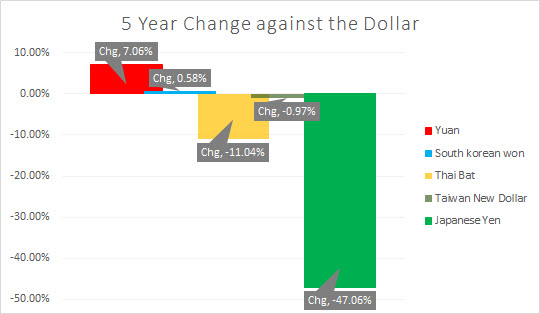
It was less than a week ago that we pinned down the growing possibility that China would move to devalue the Yuan. Then – Bang! Since this morning, it's a done deal. Or is it? While China's move to devalue the Yuan (by roughly 1.9%) in a single day is the most aggressive Yuan devaluation since the "roaring" nineties, chances are this is only the beginning.
China Must Regain its Competitiveness
The core of the matter here is that China is trying to maintain the facade that this was a one-shot deal. However, it really has more to do with the government's attempt to free the Yuan rate. Beijing, it seems, may have finally bowed to the realities of market economics. Even as it enacts reforms to liberalize its financial markets and change its economic model, China must regain its competitiveness when it comes to exports.
The chart below illustrates the Chinese Yuan over the past five years. Even after the 1.9% depreciation it is still up by 7% against the US Dollar. When compared to its peers, the Yuan stands out as the only currency to dramatically appreciate. Against the Dollar, while the Yuan gained 7%, the South Korean Won barely budged, nor did the Taiwan New Dollar. Meanwhile, the Thai Bat depreciated by 11% while the Japanese Yen shed a whopping 47% of its value. Those currencies represent China's fiercest competitors in terms of exports. The Yuan's appreciation against the Dollar, even as its rivals depreciated (and some quite aggressively) emphasizes just how much competitiveness China has lost to Asian rivals. This clearly means that more depreciation of the Yuan is warranted in order to allow China to regain export momentum.

Economic Data Will Set the Pace
When reading through China's statement on the Yuan depreciation, the language and tone brings to mind something akin to a rate cut. In fact, given the importance of exports to China's economy, the Yuan's devaluation is actually far more powerful. China is going about the devaluation process as pure monetary stimulus, thus Beijing will likely wait for more deterioration of its economic indicators before devaluating the Yuan again. But rest assured, as the chart illustrates, China still has a long way to go in order to catch up with its competitors in the region and the world. Though China can't be expected to retrace the remaining 7% of the Yuan's half decade of gains, certainly another 3-4% of Yuan devaluation will be required to finally allow the Chinese Dragon to re-emerge from the abyss.
Look for my post next week.
Best,
Lior Alkalay
INO.com Contributor - Forex
Disclosure: This article is the opinion of the contributor themselves. The above is a matter of opinion provided for general information purposes only and is not intended as investment advice. This contributor is not receiving compensation (other than from INO.com) for their opinion.

China may think fit devaluation as an ultimate solution for its Economy trouble, however, I fully doubt about the possible impacts thereof, and also it is just cant even imagine, that devaluation measure will be whether prove as a Drug or Deceases? and if it will be a Drug, that will be bound to be continued.
Sorry about that, but the author has totally missed the core reasons for the Chinese recent actions. First, the State Administration for Foreign Exchange (SAFE) has been running a typical long-term Chinese Pilot program, and it has just now implemented its resulting reforms for future control. As indicated, a major devaluation has been included and applied.
On Monday, 8/10/2015, SAFE's Middle Exchange Rate was 6.1162. On Tuesday, 8/11/2015, it was 6.2298. On Wednesday, 8/12/2015, it was 6.3306. It appears that on Thursday, 8/13/2015 it may again be higher.
These actions have no relation to China's competitiveness. China has no serious competition for its infrastructure projects. 70 countries have already requested high-speed railway projects that will keep China busy for many years.
Hi Kilroy,
Thank you for your comment.
First of all here are some facts. The SAFE you mention is also in charge of china's current account that encompasses capital flows and trade balance , both are directly related to china's competitiveness.
Secondly, the head administrator of the SAFE is Yi Gang which is also the deputy governor of the People's bank of China. So you can't say monetary policy is not driving the decisions in the SAFE.
And as per your remarks on infrastructure, first china has a lot of competitors in the field including Turkey that has the benefit if of a much lower Lira.Moreover its not china's main exports.Finally with Chinese exports plunging roughly 8% after being stagnate you really can't say china is not losing its competitive edge.
Spot on Alkalay. Really spot on. Considering China's quest for SDR membership, and what impact such intervention may have on that ambition, it leaves us with little room to doubt that this had to do with competition and the need to shore up first.
Great response Lior. Thank you!
How does the dollar stand at the moment after devaluation ?
Hi Dick ,
Well this is of course my own personal opinion but you can look at my previous article on how I think this could impact the dollar.
http://www.ino.com/blog/2015/08/dollars-fate-to-be-decided-in-beijing/#.Vcs2RPmqqko